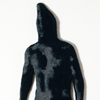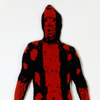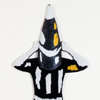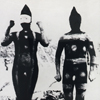Tierra del Fuegians. 1986–87 Click on images to view project. |
 |
||||||||
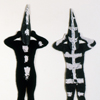 |
|
|
|
|||||
This work is based on a cache of ethnographic photographs of indigenous Fuegians taken between 1908 and about 1928 by German Jesuit missionary and anthropologist Martin Güsinde, on the islands of Tierra del Fuego. Originally, Fuegians endured their harsh, cold, and rainy climate without any clothing, simply oiling their bodies, wearing loose pelts, and setting the huge fires that led Ferdinand Magellan to name the islands Tierra del Fuego (land of fire) upon his first contact in 1520. Spanish missionaries introduced clothing bearing germs for which the Fuegians had no immunity, and over the next three-and-a-half centuries, European diseases decimated the Fuegian population. By the time of Güsinde’s visit, Fuegians were on the verge of extinction. Güsinde’s photographs show Fuegians with their oiled bodies daubed with ceremonial paint and wearing masks, posed somewhat awkwardly against a cropped landscape background. As ethnographic records, they raise many interesting questions about photographing other cultures, about what information can be acquired from a photograph, and about how such images are read by a receiving culture far removed, in every aspect, from the original context. Added to these issues is the pathos of attempting to document a vanishing culture. Repainting the Fuegian patterns on my reproductions of the photographs is a way of signaling the potential of images of foreign cultures to become foils for the fantasies of their viewers. I deliberately misread the body-paint pictographs as abstract designs and chose colors long associated with modernist painting—red, yellow, blue, and gray—in place of the original colors, which already had been abstracted as gray tones in the black-and-white photographs. The knitted copies repeat this misreading of color and further abstract and isolate the figures against the gallery wall. (Some of the knitted figures replicate the subjects of similar photographs that are not present.) The formal translation from photograph to knitting echoes the way information is passed between languages and shaped by them in different ways. In this work, photographic “truth” is as absent as the bodies of the Fuegians.
|

